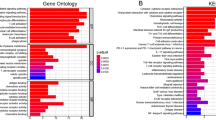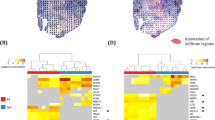Abstract
Rheumatoid arthritis (RA) is a heterogeneous disease. We used cDNA microarray technology to subclassify RA patients and disclose disease pathways in rheumatoid synovium. Hierarchical clustering of gene expression data identified two main groups of tissues (RA-I and RA-II). A total of 121 genes were significantly higher expressed in the RA-I tissues, whereas 39 genes were overexpressed in the RA-II tissues. Among the 121 genes overexpressed in RA-I tissues, a relative majority of nine genes are located on chromosome 6p21.3. An interpretation of biological processes that take place revealed that the gene expression profile in RA-I tissues is indicative for an adaptive immune response. The RA-II group showed expression of genes suggestive for fibroblast dedifferentiation. Within the RA-I group, two subgroups could be distinguished; the RA-Ia group showed predominantly immune-related gene activity, while the RA-Ib group showed an additional higher activity of genes indicative for the classical pathway of complement activation. All tissues except the RA-Ia subgroup showed elevated expression of genes involved in tissue remodeling. These results confirm the heterogeneous nature of RA and suggest the existence of distinct pathogenic mechanisms that contribute to RA. The differences in expression profiles provide opportunities to stratify patients based on molecular criteria.
This is a preview of subscription content, access via your institution
Access options
Subscribe to this journal
Receive 6 digital issues and online access to articles
$119.00 per year
only $19.83 per issue
Buy this article
- Purchase on Springer Link
- Instant access to full article PDF
Prices may be subject to local taxes which are calculated during checkout




Similar content being viewed by others
References
Tak PP, Bresnihan B . The pathogenesis and prevention of joint damage in rheumatoid arthritis: advances from synovial biopsy and tissue analysis. Arthrit Rheum 2000; 43: 2619–2633.
Firestein GS, Zvaifler NJ . How important are T cells in chronic rheumatoid synovitis? II. T cell-independent mechanisms from beginning to end. Arthrit Rheum 2002; 46: 298–308.
Arnett FC, Edworthy SM, Bloch DA et al. The American Rheumatism Association 1987 revised criteria for the classification of rheumatoid arthritis. Arthrit Rheum 1988; 31: 315–324.
Feldmann M, Maini RN . Anti-TNF alpha therapy of rheumatoid arthritis: what have we learned? Annu Rev Immunol 2001; 19: 163–196.
Bannwarth B, Pehourcq F, Schaeverbeke T, Dehais J . Clinical pharmacokinetics of low-dose pulse methotrexate in rheumatoid arthritis. Clin Pharmacokinet 1996; 30: 194–210.
Walker JS, Sheather-Reid RB, Carmody JJ, Vial JH, Day RO . Nonsteroidal antiinflammatory drugs in rheumatoid arthritis and osteoarthritis: support for the concept of ‘responders’ and ‘nonresponders’. Arthrit Rheum 1997; 40: 1944–1954.
Ulfgren AK, Grondal L, Lindblad S et al. Interindividual and intra-articular variation of proinflammatory cytokines in patients with rheumatoid arthritis: potential implications for treatment. Ann Rheum Dis 2000; 59: 439–447.
Takemura S, Braun A, Crowson C et al. Lymphoid neogenesis in rheumatoid synovitis. J Immunol 2001; 167: 1072–1080.
Shi K, Hayashida K, Kaneko M et al. Lymphoid chemokine B cell-attracting chemokine-1 (CXCL13) is expressed in germinal center of ectopic lymphoid follicles within the synovium of chronic arthritis patients. J Immunol 2001; 166: 650–655.
Eisen MB, Spellman PT, Brown PO, Botstein D . Cluster analysis and display of genome-wide expression patterns. Proc Natl Acad Sci USA 1998; 95: 14863–14868.
Deighton CM, Walker DJ, Griffiths ID, Roberts DF . The contribution of HLA to rheumatoid arthritis. Clin Genet 1989; 36: 178–182.
Caron H, van Schaik B, van der MM et al. The human transcriptome map: clustering of highly expressed genes in chromosomal domains. Science 2001; 291: 1289–1292.
Quadri SA, Taneja V, Mehra NK, Singal DP . HSP70-1 promoter region alleles and susceptibility to rheumatoid arthritis. Clin Exp Rheumatol 1996; 14: 183–185.
Auger I, Escola JM, Gorvel JP, Roudier J . HLA-DR4 and HLA-DR10 motifs that carry susceptibility to rheumatoid arthritis bind 70-kD heat shock proteins. Nat Med 1996; 2: 306–310.
Kang YM, Zhang X, Wagner UG et al. CD8 T cells are required for the formation of ectopic germinal centers in rheumatoid synovitis. J Exp Med 2002; 195: 1325–1336.
Fukui Y, Hashimoto O, Sanui T et al. Haematopoietic cell-specific CDM family protein DOCK2 is essential for lymphocyte migration. Nature 2001; 412: 826–831.
Moore PA, Belvedere O, Orr A et al. BLyS: member of the tumor necrosis factor family and B lymphocyte stimulator. Science 1999; 285: 260–263.
Ansel KM, Cyster JG . Chemokines in lymphopoiesis and lymphoid organ development. Curr Opin Immunol 2001; 13: 172–179.
Steeber DA, Green NE, Sato S, Tedder TF . Lymphocyte migration in L-selectin-deficient mice. Altered subset migration and aging of the immune system. J Immunol 1996; 157: 1096–1106.
Gulati P, Guc D, Lemercier C, Lappin D, Whaley K . Expression of the components and regulatory proteins of the classical pathway of complement in normal and diseased synovium. Rheumatol Int 1994; 14: 13–19.
Guc D, Gulati P, Lemercier C et al. Expression of the com-ponents and regulatory proteins of the alternative complement pathway and the membrane attack complex in normal and dis-eased synovium. Rheumatol Int 1993; 13: 139–146.
Maccioni M, Zeder-Lutz G, Huang H et al. Arthritogenic monoclonal antibodies from K/BxN mice. J Exp Med 2002; 195: 1071–1077.
Steck E, Benz K, Lorenz H et al. Chondrocyte expressed protein-68 (CEP-68), a novel human marker gene for cultured chondrocytes. Biochem J 2001; 353: 169–174.
Xue C, Takahashi M, Hasunuma T et al. Characterisation of fibroblast-like cells in pannus lesions of patients with rheumatoid arthritis sharing properties of fibroblasts and chondrocytes. Ann Rheum Dis 1997; 56: 262–267.
Bi W, Deng JM, Zhang Z, Behringer RR, de Crombrugghe B . Sox9 is required for cartilage formation. Nat Genet 1999; 22: 85–89.
Burger JA, Zvaifler NJ, Tsukada N, Firestein GS, Kipps TJ . Fibroblast-like synoviocytes support B-cell pseudoemperipolesis via a stromal cell-derived factor- 1- and CD106 (VCAM-1)-dependent mechanism. J Clin Invest 2001; 107: 305–315.
Kukita A, Bonewald L, Rosen D et al. Osteoinductive factor inhibits formation of human osteoclast-like cells. Proc Natl Acad Sci USA 1990; 87: 3023–3026.
Kong YY, Boyle WJ, Penninger JM . Osteoprotegerin ligand: a regulator of immune responses and bone physiology. Immunol Today 2000; 21: 495–502.
Nakamura S, Kamihagi K, Satakeda H et al. Enhancement of SPARC (osteonectin) synthesis in arthritic cartilage. Increased levels in synovial fluids from patients with rheumatoid arthritis and regulation by growth factors and cytokines in chondrocyte cultures. Arthrit Rheum 1996; 39: 539–551.
He X, Saint-Jeannet JP, Wang Y et al. A member of the Frizzled protein family mediating axis induction by Wnt-5A. Science 1997; 275: 1652–1654.
Sen M, Lauterbach K, El Gabalawy H et al. Expression and function of wingless and frizzled homologs in rheumatoid arthritis. Proc Natl Acad Sci USA 2000; 97: 2791–2796.
Glinka A, Wu W, Delius H et al. Dickkopf-1 is a member of a new family of secreted proteins and functions in head induction. Nature 1998; 391: 357–362.
Ladher RK, Church VL, Allen S et al. Cloning and expression of the Wnt antagonists Sfrp-2 and Frzb during chick development. Dev Biol 2000; 218: 183–198.
Perou CM, Jeffrey SS, van de Rijn M et al. Distinctive gene expression patterns in human mammary epithelial cells and breast cancers. Proc Natl Acad Sci USA 1999; 96: 9212–9217.
Tusher VG, Tibshirani R, Chu G . Significance analysis of microarrays applied to the ionizing radiation response. Proc Natl Acad Sci USA 2001; 98: 5116–5121.
Gollub Y, Ball CA, Binkley G et al. The Stanford Microarray Database: data access and quality assessment tools. Nucleic Acids Res. 2003; 31: 94–96.
Van der Pouw Kraan TCTM, van Gaalen FA, Kasperkovitz PV et al. Rheumatoid Arthritis is a heterogeneous disease: evidence for differences in the activation of the STAT-1 pathway between Rheumatoid tissues. Arthritis Rheum. 2003; In press.
Acknowledgements
We are grateful to Drs Patrick O. Brown and David Botstein in whose laboratories most of the work described in this report was performed. The work carried out in Patrick O. Brown's lab was supported by the Howard Huges Medical Institute and a grant from the NCI.
Author information
Authors and Affiliations
Corresponding author
Additional information
This study was financially supported in part by the Howard Hughes Medical Institute, a grant from the National Cancer Institute, a research grant from The Netherlands Organization for Scientific Research and the Dutch Arthritis Association.
Rights and permissions
About this article
Cite this article
van der Pouw Kraan, T., van Gaalen, F., Huizinga, T. et al. Discovery of distinctive gene expression profiles in rheumatoid synovium using cDNA microarray technology: evidence for the existence of multiple pathways of tissue destruction and repair. Genes Immun 4, 187–196 (2003). https://doi.org/10.1038/sj.gene.6363975
Published:
Issue Date:
DOI: https://doi.org/10.1038/sj.gene.6363975
Keywords
This article is cited by
-
Understanding of sarcopenia: from definition to therapeutic strategies
Archives of Pharmacal Research (2021)
-
Synovial tissue transcriptomes of long-standing rheumatoid arthritis are dominated by activated macrophages that reflect microbial stimulation
Scientific Reports (2020)
-
Levels of CXCL13 and sICAM-1 correlate with disease activity score in patients with rheumatoid arthritis treated with tocilizumab
Advances in Rheumatology (2019)
-
Molecular profiling of rheumatoid arthritis patients reveals an association between innate and adaptive cell populations and response to anti-tumor necrosis factor
Arthritis Research & Therapy (2019)
-
Moving towards a molecular taxonomy of autoimmune rheumatic diseases
Nature Reviews Rheumatology (2018)



